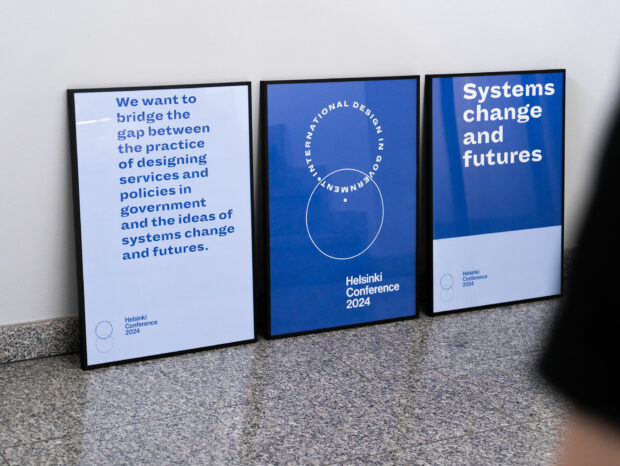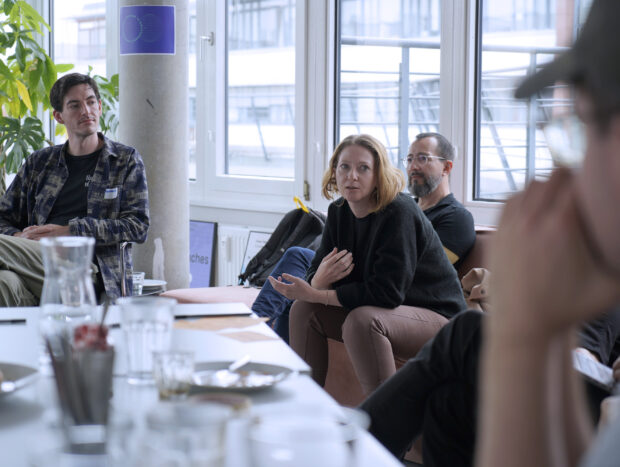
The International Design in Government community has been bringing together public servants interested in design for 7 and a half years. After starting online in 2017, we quickly organised our first in-person event only a year later. While we continue running our online exchange through calls, chats and remote workshops, our community longs for face-to-face interactions. That is why we are returning with several activities this year.
As announced in our January update, we are working with colleagues and community members from the Nordics to organise our first in-person conference since 2019.
The Helsinki conference 2024
From 1 to 2 October 2024, the Finnish government design community Julkis-muotoilijat is partnering with us for an International Design in Government community conference. The conference will run adjacent to the Service Design Global Conference which is being hosted in Helsinki this year.
Julkis-muotoilijat is collaboratively organising and running the conference with Aalto University’s Design for Government programme, the Department of Culture at the City of Malmö (Sweden), the City of Helsinki (Finland), and designers from the City of Tallinn and the Estonian government. This is a genuine community approach!
Preparation is in full swing, with a full agenda of speakers announced and sold-out tickets. Participants are joining from over 30 countries, including 20 in Europe. With our community goal of increasing global representation, we are delighted to have registered attendees from Argentina, Australia, Brazil, Canada, Chile, India, Japan, Mexico, Singapore, Thailand, and the United States. The conference speakers will represent 15 different countries, territories and nations.
The theme of the conference is ‘systems change and futures’.
To develop the theme, the organising team ran a workshop with conference volunteers. They agreed on 8 themes and included them in a call for ideas shared with community members. The team received 129 responses from across all continents. The call for ideas asked people to vote on their theme preference and share further ideas and topics they’d like to have included. ‘From reactive to proactive government: emerging futures thinking in government’ was the theme with the most votes. You can read more about the theme development in Anni Leppänen’s post.
The 2-day conference will be multi-track and will cover:
- case studies of change-making
- systems
- futures
- behaviour, ethics and participation
- sustainability
In addition, there will be a participant experience track to give space for networking and reflection.
This conference is different from past ones – with the inclusion of academia. This year marks 10 years of the renowned Design for Government (DfG) course at Aalto University in Helsinki. With this proximity and many alums working in public sector organisations, 50 tickets were reserved for academics and there is a specific academic track. We’re excited to widen the event to include this crucial group that influences the awareness, direction and measurement of public service design.
We’re continuing to update the conference website which now includes more information for participants, such as travel and accommodation tips.
To complement the event, we’re creating the next issue of the Service Gazette.
Helping make common service patterns work globally
In mid-June, we attended the Creative Bureaucracy Festival in Berlin – this time as participants rather than speakers like last year. Taking advantage of the many public sector colleagues in town, we organised a workshop on global design patterns on Friday, 14 June, the day after the festival.
Impressed by collaborative work initiated by Estonia, Germany, the United Nations International Telecommunication Union (ITU), and Digital Impact Alliance (DIAL), we wanted community members to take a closer look at the outputs of the GovStack initiative. During last year’s Berlin activities, we already heard about the ongoing development of global design patterns, but lacked the time to engage with them fully. So, we wanted to catch up at the next possible opportunity.

For the whole morning, we invited international colleagues to review the service patterns developed for GovStack. GovStack is a toolbox for governments across the world to build digital public services at scale. It shares and documents tools, knowledge and international best practices. A core section is dedicated to user experience and user interface guidelines.
Partnering with the creators, designers Betty Mwema and Laurence Berry, we had community members from Brazil, Germany, the Netherlands and the United Kingdom looking at service patterns, service design good practice guidelines and common user flow templates. We wanted to see how designers could use them in their work context.
After an introduction to the work and patterns, to work effectively, the attendees split into 3 groups:
- people working on design patterns
- people working with design patterns
- people interested in working with design patterns
In these groups, participants discussed what’s valuable, what’s missing, and the limits of these patterns. The GovStack patterns were informed and inspired by other great work done in Essex County Council, the Helsinki Design System, and Japan’s Digital Agency.
The breakouts shaped the next phase of the working group, which will focus on 3 areas:
- testing and further exploring the application of the patterns
- improving the communication about the purpose, benefits and usage of the content
- documenting new patterns
People expressed interest in a remote version when we announced the workshop. On 24 September, everyone interested in the service patterns work can participate in an online workshop, contribute to their next iteration and learn more about joining the working group.

More community calls on timely topics
We restarted our regular calls in June with another call on service standards. It was our third call on the topic after we previously discussed it in 2020 and 2021. This time, we had contributions from Andy Jones and Kerry Lyons, who shared how standards and service assurance are supported and implemented at the UK’s Department for Education. Ignacia Orellana talked about her work developing a data service standard for Maipú, a municipality in Santiago de Chile. We had some 40 people from at least four different time zones joining us.
We have ideas for another call on service quality standards. Next, we also want to discuss designing better policies, using artificial intelligence for design, and designing justice services. Many proposals for the Helsinki conference couldn’t fit into the programme, so we’ll also try to include them in our upcoming calls, too.
We hope to see you in Helsinki or on an online call. Please continue to share ideas for our list of call topics. You can learn more about the community and how to sign up on the community website.
Looking further ahead: let us know if you’re interested in hosting any small or bigger events anywhere in 2025. We are happy to support you with a conference playbook developed over the years, drawing from the collective community experience since 2018.
